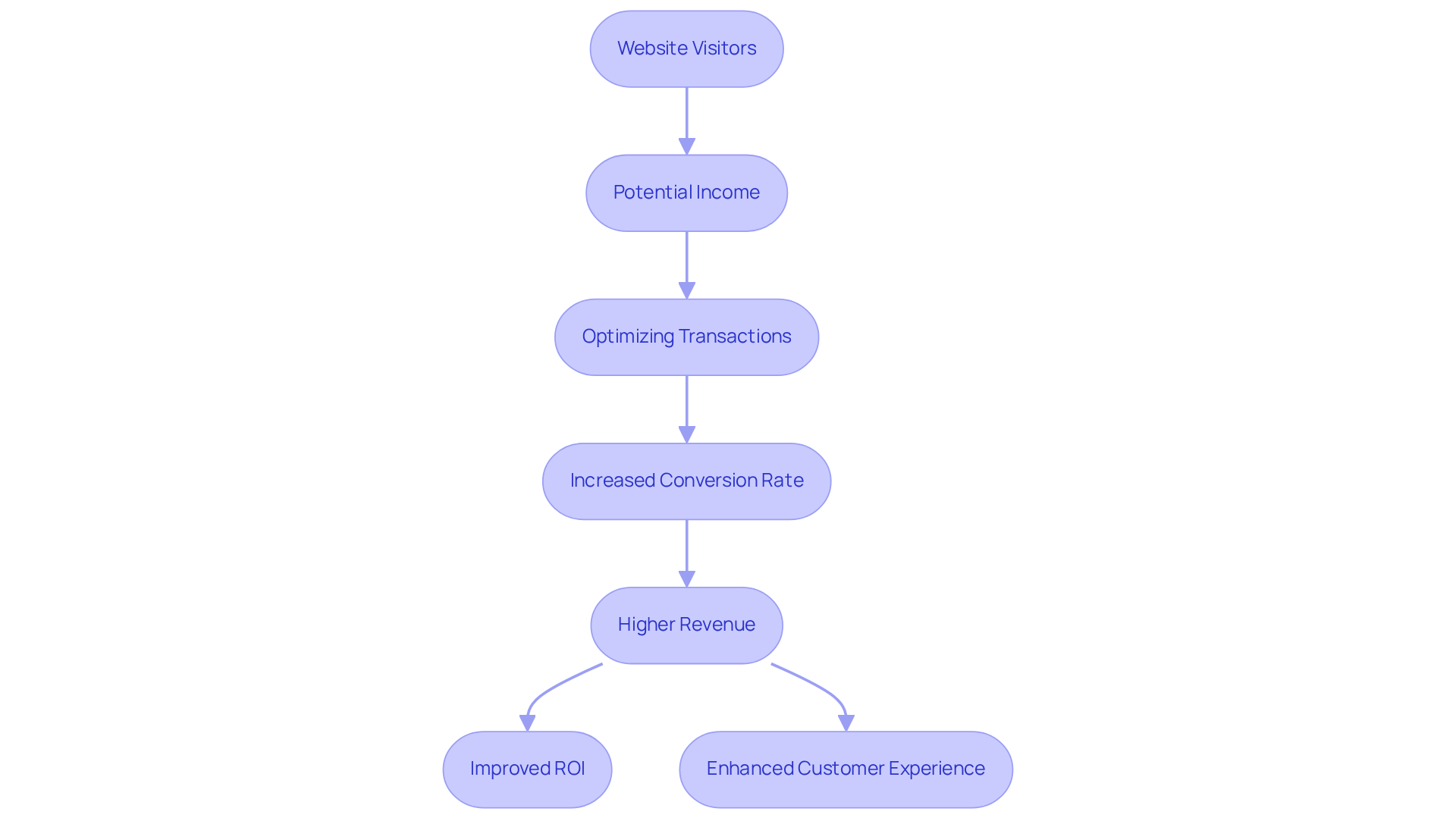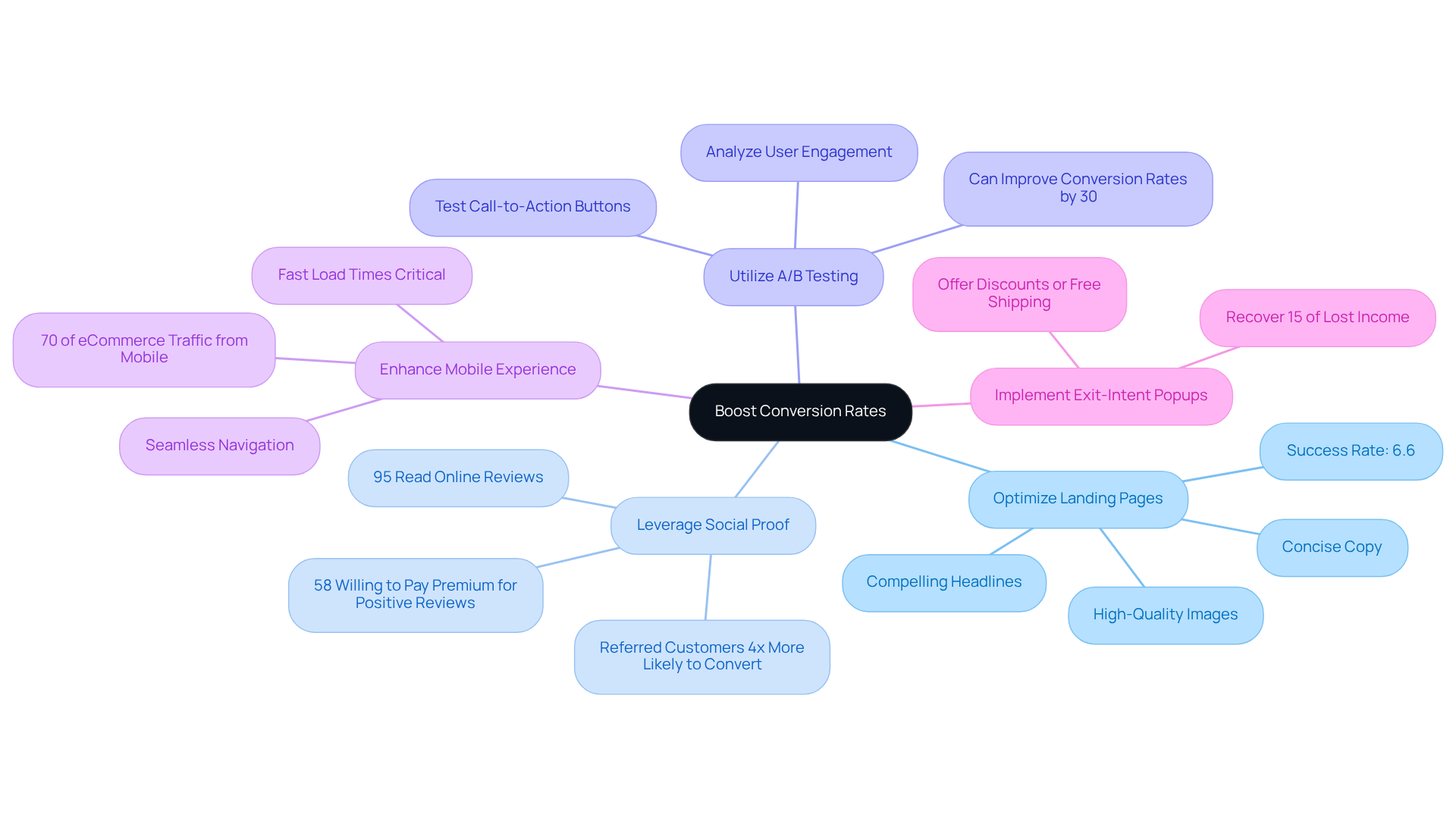
Overview
This article examines how direct-to-consumer (DTC) brands can significantly enhance online conversions through a series of proven strategies. By:
- Optimizing landing pages
- Leveraging social proof
- Conducting A/B testing
- Enhancing mobile experiences
- Implementing exit-intent popups
brands can substantially improve their conversion rates. These strategies not only drive revenue but also foster customer loyalty, establishing a robust foundation for sustainable growth.
Introduction
For direct-to-consumer (DTC) brands, the digital marketplace transcends being merely a platform; it serves as a vital lifeline that profoundly influences profitability. Each website visitor embodies the potential to convert into revenue, positioning the optimization of online conversions as a critical focus for success. This article explores proven strategies designed to significantly enhance conversion rates, equipping brands with the essential tools to maximize their existing traffic while cultivating loyalty and encouraging repeat purchases.
How can DTC companies adeptly navigate the complexities of online consumer behavior to ensure that every visitor evolves into a valuable customer?
Understand the Importance of Online Conversions for DTC Brands
For direct-to-consumer (DTC) companies, online transactions are not just important; they are essential for profitability. Each visitor to a website represents potential income, and optimizing the success of these transactions ensures that a greater percentage of these visitors complete a purchase.
With escalating customer acquisition costs, it is increasingly crucial for brands to . A focus on sales performance not only drives revenue but also enhances the overall customer experience, fostering greater loyalty and repeat purchases.
Brands that prioritize optimization can expect significant improvements in their return on investment (ROI) and average order values (AOV). For instance, a DTC company that boosts its success rate by just 1% can witness a substantial increase in revenue, underscoring its importance as a critical area for sustainable growth.

Implement Proven Strategies to Boost Conversion Rates
To effectively boost conversion rates, DTC brands must implement proven strategies that yield substantial results:
- Optimize Landing Pages: Design landing pages with a clear focus on the desired action, whether it's making a purchase or signing up for a newsletter. Compelling headlines, high-quality images, and concise copy are essential to engage visitors. A well-organized landing page can achieve success levels of approximately 6.6%, as evidenced by an examination of 41,000 landing pages with 464 million visitors, making online conversions optimization crucial.
- Leverage Social Proof: Incorporate customer reviews, testimonials, and case studies to build trust and credibility. Research indicates that referred customers are than average new customers. Additionally, 95% of consumers read online reviews before making a purchase decision, and 58% of shoppers are willing to pay a premium for products with positive reviews, underscoring the effectiveness of social proof in influencing purchasing behavior.
- Utilize A/B Testing: Regularly test different elements of your website, such as call-to-action buttons, images, and copy. A/B testing can enhance success levels by as much as 30% on average, enabling companies to determine what resonates most with their audience and make informed choices based on data, particularly through analyzing online conversions.
- Enhance Mobile Experience: With nearly 70% of eCommerce traffic in the U.S. coming from mobile devices, ensuring a seamless mobile experience is paramount. Optimize website design for mobile users by ensuring fast load times and easy navigation, as a site that loads in one second converts three times better than one that takes five seconds.
- Implement Exit-Intent Popups: Capture potential customers who are about to leave the site by offering them incentives, such as discounts or free shipping. Exit-intent popups can recover up to 15% of lost income from abandoned checkouts, significantly enhancing overall success percentages.
By implementing these tactics, DTC companies can create a more captivating and efficient online shopping experience that focuses on online conversions, ultimately resulting in greater sales and enhanced revenue.

Adopt a Culture of Continuous Testing and Optimization
To maintain a competitive advantage, DTC companies must cultivate a culture of ongoing testing and enhancement. This involves:
- Regularly Reviewing Analytics: Leverage analytics tools to monitor website performance and user behavior. Understanding visitor interactions can reveal , guiding future strategies. For instance, companies that examine their traffic origins can tailor their marketing strategies to enhance success levels efficiently.
- Setting Clear Objectives: Establish specific, measurable targets for transformation metrics and key performance indicators (KPIs). This clarity enables teams to concentrate their efforts and accurately gauge success. Aiming for an average success percentage of 5% serves as a solid benchmark for many DTC brands, while striving for percentages above 3.2% positions them within the top 20% of Shopify stores. Notably, a transformation rate of 4.7% ranks among the top 10% of Shopify stores, providing a clearer context for high performance.
- Encouraging Team Collaboration: Promote collaboration among marketing, design, and development teams to ensure all website aspects align with conversion goals. A unified approach can lead to innovative solutions and expedited implementation of changes, enhancing overall performance. Approximately 75% of the top 500 online retailers utilize A/B testing platforms, underscoring the significance of collaboration in testing and enhancement efforts.
- Staying Informed on Industry Trends: Stay abreast of the latest trends in e-commerce and consumer behavior. Adapting to market shifts can reveal improvement opportunities that competitors might overlook. For example, incorporating video material can elevate success rates by up to 86%, as evidenced in effective landing pages.
- Celebrating Wins and Learning from Losses: Recognize and celebrate successful improvement initiatives while analyzing what did not succeed. This mindset encourages experimentation and creativity, essential for a robust performance improvement strategy. Brands that engage in systematic testing can validate assumptions and discover new enhancement opportunities, resulting in improved online conversions. Furthermore, steering clear of common pitfalls in A/B testing, such as implementing only minor changes, can bolster the effectiveness of these efforts.
By embedding a culture of continuous testing and optimization into their operations, DTC brands can ensure they consistently improve and adapt to meet customer needs, ultimately driving sustained growth and profitability. The methodologies employed by Parah Group have yielded measurable improvements, including a 36% increase in ROI on ads for clients, illustrating the potential impact of these practices.

Conclusion
For DTC brands, the journey toward maximizing online conversions transcends mere tactics; it is a strategic imperative that profoundly impacts profitability and market presence. By meticulously optimizing every facet of the online shopping experience, brands can convert casual visitors into loyal customers, ensuring that each interaction is laden with potential for increased revenue and customer loyalty.
Throughout this article, we have highlighted several key strategies, including:
- The critical importance of well-designed landing pages
- Leveraging social proof
- Utilizing A/B testing
- Enhancing mobile experiences
- Implementing exit-intent popups
Each of these tactics is instrumental not only in boosting conversion rates but also in cultivating a more engaging and effective online shopping environment. Moreover, fostering a culture of continuous testing and optimization empowers brands to adapt to shifting consumer behaviors and preferences, thereby maintaining competitiveness in a rapidly evolving marketplace.
Ultimately, the significance of online conversions for DTC brands is paramount. By embracing these proven strategies and committing to ongoing improvement, brands can unlock their full potential and drive sustainable growth. The future of DTC success hinges on the ability to effectively convert website traffic into tangible sales, making it essential for brands to prioritize these practices and remain vigilant in their pursuit of excellence.
Frequently Asked Questions
Why are online conversions important for DTC brands?
Online conversions are essential for DTC brands because they directly impact profitability. Each website visitor represents potential income, and optimizing transactions ensures a higher percentage of visitors complete a purchase.
How do customer acquisition costs affect DTC brands?
As customer acquisition costs rise, it becomes increasingly important for DTC brands to maximize the value from their existing traffic. This focus on sales performance helps drive revenue and improve the overall customer experience.
What benefits do brands experience by prioritizing optimization?
Brands that prioritize optimization can see significant improvements in return on investment (ROI) and average order values (AOV). Even a small increase in the success rate of transactions can lead to substantial revenue growth.
What is the impact of a 1% increase in success rate for a DTC company?
A DTC company that boosts its success rate by just 1% can experience a significant increase in revenue, highlighting the importance of focusing on online conversions for sustainable growth.
FAQs











